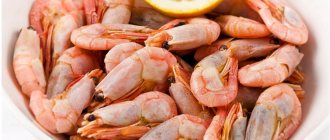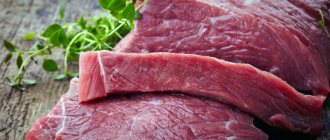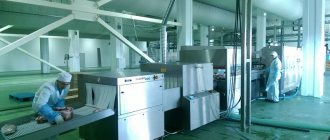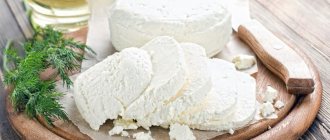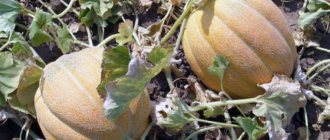Jamon is dry-cured pork meat. It belongs to traditional Spanish dishes. You can store jamon at home only if it is of high quality and fresh. When buying it in a store, you should carefully check that there is no water or mucus on the surface. One of the indicators of quality is the presence of a thin film of mold on the shell.
How to choose
Before organizing the storage of jamon, you should purchase it. Storage is possible only if the product is fresh and of high quality. Therefore, when purchasing it, you need to make sure that:
- there is no mucus or moisture on the surface;
- at temperatures above +18°C shine and a bright aroma appear;
- a thin film of mold is visible on the shell (a quality indicator).
How to store jamon at home depends on its type. If the product is purchased as a whole piece, it can be stored for up to 12 months.
Jamon on the bone should be stored at a temperature no higher than +18°C (cellar, basement). But if the product is purchased already sliced, it must be kept at a temperature no higher than +5°C (refrigerator). Otherwise, the shelf life of jamon is significantly reduced.
How to tell if jamon has gone bad
You can determine the spoilage of dried pork ham by the following signs:
- Mold formation on the surface. Only relevant for slicing.
- Unpleasant putrid odor.
- Change in color (meat has become dark).
- Formation of mucus on the surface. Also only applies to sliced pork.
- Taste of rancid fat.
Spoiled jamon should not be consumed, as this can lead to poisoning . But, in the case of meat on the bone, there is an important nuance - the appearance of mold is not the cause of spoilage. This is the so-called noble mold. It can be simply removed by wiping with a cloth soaked in olive oil. If mold has already appeared on the cut pieces, they should be thrown away.
Under what conditions should it be stored?
Whole pieces of this product should be kept out of the refrigerator. The storage temperature for jamon should be between +15°C and +20°C. In a warmer place, the meat may begin to rot, and in the cold, it will lose its taste.
During storage, it is undesirable to use any packaging (foil, film, paper). Insufficient air will negatively affect the quality of the product. You also need to remove the store packaging from it, and then hang it in a cool room or on a balcony at normal temperature.
You should not store bone-in jamon next to foods that have a strong odor.
If mold appears, the meat is treated with olive oil, and it should absolutely not be frozen. Although the product will last quite a long time, its taste will be irretrievably lost.
Common Mistakes
Whole jamon should be stored indoors, and cut jamon should be stored in the refrigerator. Freezing the delicacy is strictly prohibited. Under the influence of negative temperatures, the moisture present in the meat crystallizes. This will negatively affect the structure of the meat.
See also
Rules and best ways to store apricots at home
To transport jamon, it is often wrapped in film. It is worth considering that within a day such meat will spoil. A sign of violations of storage rules is the appearance of yellow fat on the surface of the product. It is recommended to cut off such fragments and discard them.
A big mistake would be storing jamon next to foods that have intense odors. Jerky absorbs unwanted flavors, causing a decrease in quality.
On the bone
Buying pulled pork on the bone, as opposed to sliced, is more cost effective. If stored properly, it can maintain its quality for a very long time.
Storing jamon on the bone should be suspended with the hoof up at a temperature of +15°C -+20°C.
It is very important that the storage temperature of the jamon is constant. Sudden changes lead to loss of product quality. In this case, it should be treated with animal fat or olive oil.
Pork purchased in vacuum packaging must be kept at a temperature of +2°C -+10°C. In this case, the fresh cut area should be immediately treated with fat to create a protective film. In such conditions, the shelf life of jamon will be 3 - 4 months. And if the storage conditions of the product are unsuitable, you will need to constantly remove rotten areas.
Factors affecting shelf life
How long the ham will remain fresh depends on the following conditions:
- Temperature . For whole ham, the optimal range is +15°C +20°C. In warmer conditions, rotting may begin; in cold conditions, the taste deteriorates.
- Humidity . The room must be sufficiently dry to avoid the risk of mold formation.
- Product type . Ham can be purchased whole or sliced. Depending on this, the conditions and shelf life differ.
- Availability of packaging . Technologists recommend storing the product without packaging at all so that its taste does not deteriorate.
- Product quality.
Storing cuttings
It is best to use cut dried pork immediately without resorting to long-term storage. If there is still a need to store sliced jamon, place it on a dish and wrap it in a damp cloth or foil, trying to do this so that the packaging and the meat do not come into contact.
The shelf life of sliced jamon in the refrigerator is 10 - 12 hours. However, it is strictly forbidden to wrap it in cling film or place it in a tightly closed plastic container.
Before eating, the meat is kept warm for about 10 minutes so that it acquires a richer taste and aroma. An indicator of proper storage of cuttings will be the shine on its surface.
Something about preparing and choosing a delicacy
The process of preparing this miracle of gastronomy consists of a very simple operation, namely, adding salt to raw meat, i.e., the hind leg of pork. Moreover, a large amount of salt is used to achieve maximum dehydration of the meat. How long does it take for drying to turn out as it should? Its duration depends on the mass of raw materials and ambient temperature, on average one day per kilogram of product.
We recommend: How long can you safely store different types of meat in the freezer?
Drying lasts from 6 to 36 months and depends on the weight of the leg, as well as climatic conditions in specific provinces of Spain. It begins, as a rule, at the end of winter or early spring, so that the process lasts throughout the summer until its end with a gradual increase and the same gradual decrease in ambient temperature. At the beginning of autumn, the jamon is transferred to lower and cool rooms with a temperature of +8...+10 °C, where it spends about another year, undergoing the drying process. At the same time, the delicacy acquires that unique taste, aroma and structure for which it is known and appreciated in many countries. The drying process takes place in two stages:
• ripening in cellars in a suspended state; • product readiness test.
An experienced expert will help you choose this coveted high-quality meat delicacy, as well as the personal preferences of lovers of this delicious representative of the gastronomic culture of Spain.
Vacuum storage
If the jamon is boneless, its quality in vacuum packaging will not change even after 12 months. But after opening, the product can last no more than 7 days.
Vacuum ham is purchased only when you plan to use it immediately, without resorting to storage. Practice shows that this is pointless. But even during short-term storage, cut meat should be treated with olive oil.
Option with lamb
Having figured out how to store jamon at home, you can see an unusual recipe for preparing this delicacy. To make a unique snack on your own that can compete worthy with store-bought sausages, you will need:
- 8 kg salt.
- Leg of lamb weighing about 2 kg.
Pour grams of salt onto a baking sheet lined with foil. Place a leg of lamb on top. All this is sprinkled with another 3.5 kg of salt and placed in any cool place for a day.
Then the leg is shaken off and placed in a clean container. Another 2 kg of salt is poured there. All this is left for two days, and then shaken and salted again. After a week, the leg of lamb is cleaned again and hung in a well-ventilated room. After seven days, the darkened jamon, the shelf life of which depends on the conditions in which it is stored, is put in the refrigerator.
Storing prosciutto
Prosciutto (translated as ham) is ham treated with salt. This product contains no other additives and consists solely of meat and salt, just like jamon. Prosciutto is native to Parma, Italy. It uses the ham of a pig that was fed exclusively corn and fruit.
Storing prosciutto is not much different from jamon, but nevertheless, it has its own rules. The cut is covered with its own skin, and if it was accidentally thrown away, with oiled parchment.
Unlike jamon, you need to cut the prosciutto a little at a time when serving it, adding more if necessary. And the slices should not touch each other in order to preserve the taste and aromatic qualities of the product as much as possible.
The portion of dried meat remaining after the meal is placed in the cold, but for no more than 12 hours. The product is first wrapped in a damp cloth without any utensils.
Prosciutto meat is less susceptible to freezing temperatures. In case of emergency, it can be frozen, but the quality of the product after defrosting will be quite questionable.
How to store jamon and prosciutto at home?
The Spanish meat delicacy - jamon, as well as its Italian counterpart - prosciutto, have ceased to be exotic even far from their native lands.
But it’s not enough to find a suitable market and buy the famous dried meat; you also need to figure out how to store the jamon. Compliance with the usual but fundamental rules will allow even a bulky pork leg to be kept in suitable condition for as long as necessary. But ignoring the advice can spoil the memory of a delicious snack and provoke food poisoning.
Storage Features
- Storage of jamon (whole drumstick) should occur at a temperature of +15 ° C - + 20 ° C. If meat is purchased as slices, storage time is significantly reduced.
- Freezing dried meat causes the moisture in the tissues to crystallize. The structure of the product will be damaged beyond repair. Therefore, it is possible to properly store jamon after defrosting in natural conditions for several hours.
- Jamon can be transported in cling film. But in such conditions it will deteriorate within 24 hours.
- If yellow fat appears on the surface of the meat, this is an indicator of improper storage. It is best to cut off the damaged areas with a knife and try to avoid consuming this product.
Fans of pulled pork shouldn't waste their money. In any case, this product is quite expensive. Read how to store jamon at home so you don’t regret wasting money.
Basic rules for storing and using dry-cured ham
The approach to creating jamon and prosciutto is approximately the same. Slightly dry Spanish or moist Italian jerky will delight you with its unique taste if the following conditions are met:
- Despite the fact that these dishes are a type of raw meat, they can only be properly stored at room temperature. Constant exposure to cold air is detrimental to ham.
- The unopened leg should be hung in the pantry or on the balcony of the house (subject to the temperature conditions), removing the packaging.
Tip: Prosciutto or jamon must breathe, so plastic wrap, foil or paper can only be used to transport the product. After just a few hours of being in an artificial casing, the meat begins to lose its taste.
- The cut product can be consumed without fear for 3-4 months, provided that the cut is properly processed and the necessary environment is created at home.
- It is not recommended to keep dried meat in close proximity to other aromatic foods. Fibers very quickly absorb foreign odors, which can lead to damage to the product.
- The appearance of mold is not a sign of damage to the jamon. Colonies of noble origin should be rubbed with a cotton cloth soaked in olive oil to return the product to its marketable condition. It is better to cut off the skin after this treatment; it may taste slightly bitter.
- Freezing in the refrigerator or freezer is strictly prohibited. No matter how many months of storage this approach promises, the taste of the meat will be hopelessly spoiled.
- Sliced jamon or prosciutto sold vacuum sealed should be consumed within a few hours of opening the package. If necessary, you can re-place the product in an airtight container, but this will not greatly increase its shelf life.
We recommend: How to preserve cabbage for the winter
We recommend: How to conveniently store documents at home?
In addition, there are several secrets for storing specific national dishes. Compliance with them will allow you to appreciate the taste and aroma of dried meat without visiting its historical homeland.
Existing varieties
There are two types of jamon made in Spain. One of them is characterized by a relatively low cost, which makes it accessible to a wide range of buyers. It is called serrano and is made from the meat of white pigs. Its ripening period ranges from seven to twelve months.
For lovers of gourmet delicacies planning a trip to Spain, we can definitely try Iberico - this is a more expensive jamon. “What kind of meat is this, what is it made from and what increases its value so much?” – many of you will ask. The basis for its production are black pigs of the Iberian breed, eating corn and grazing in the mountains. Several months before slaughter they are fed acorns. This allows you to achieve a special taste and aroma of meat.
